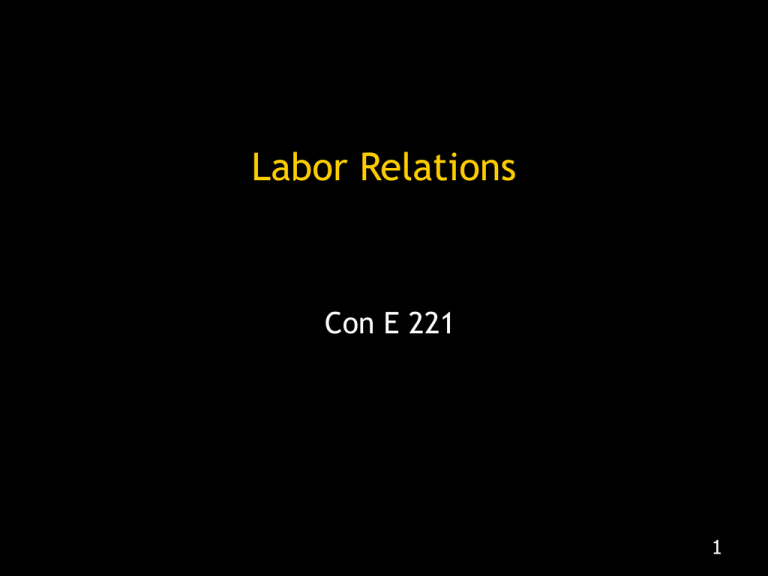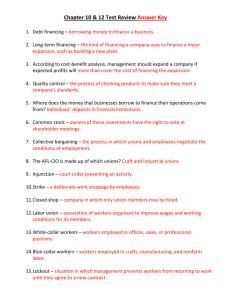Labor Relations Con E 221 11
advertisement

Labor Relations Con E 221 1 The Construction Worker For the most part – a skilled artisan with no permanent place of employment The average construction worker has no fixed relationship with any one contractor, and his tenure of employment with a given employer is normally indefinite and temporal (not necessary a bad situation) Why is it important to understand this aspect of a construction workers life? 2 Percent Change in Construction Employment (June 99 – June 00) Overall construction +4.5% Residential +3.9 Nonresidential +3.2 Highway and street +2.0 Special trade contractors +5.4 Manufacturing -0.1 Total U.S. employment +2.4 3 Construction Industry Employment Largest single economic effort in our nation Provides about 6% of the total national civil employment 9% of all construction workers are women Relies on a younger work force – 25% are 30 years and younger 4 Median Hourly Earnings for Non-Union Construction Labor in 2001 Electrician Journeyman Bricklayers Carpenters $23.10 $22.80 $19.72 Source: ENR – Third Quarterly Cost Report, 9/30/02 5 Median Annual Earnings for Construction Managers in 2000 Electrical work $60,300 Nonresidential building construction $59,470 Plumbing, heating, and air-conditioning $58,500 Heavy construction, except highway $57,280 Residential building construction $53,510 6 Construction Engineering Graduates According to a 2001 salary survey by the ISU College of Engineering, candidates with a bachelor’s degree in construction engineering received job offers averaging $42,732 a year. 7 Employee Benefits Which of the following employee benefits are mandated by law? A. B. C. D. Social Security (F.I.C.A.) Medicare Worker’s Compensation All of the above 8 Voluntary Employee Benefits Pension plans Profit Sharing Medical Insurance Life Insurance Paid Vacations Paid Holidays Sick Leave Bonuses 401k Plans Employee Stock Ownership Plans 9 Cost of Fringe Benefits 25 to 30% of wages paid $45,000 / YR Salary $13,500 / YR Cost of Fringe Benefits 10 The Union Contractor Open shop Hired directly by and works for their employer Hourly pay rate set by contractor and may vary per worker Union shop Hired through a union hall Work under a union foreman Union membership is required to work All workers of same type (i.e. journeyman carpenter) are all paid the same hourly wage per union contract 11 Role of the Unions Unions have a stabilizing influence on a basically unstable area of business 12 Union History Originated 150 years ago Stable in the U.S for only about the past 50 yrs. American Federation of Labor – 1886 Skilled craft worker Construction trades - charter member of AFL Congress of Industrial Organization – 1938 split from AFL in 1936 Rejoined AFL in 1955 Today known as AFL-CIO 13 AFL-CIO Construction Unions How many unions form the Building and Construction Trades Department of the AFL-CIO? A. 8 B. 10 C. 12 D. 14 E. 20 Correct answer is D. 14 Approximately what percentage of the construction industry work force is unionized? A. 12 B. 20 C. 25 D. 28 Correct answer is C. 25% E. 32 14 Union Work Rules Written in collective bargaining agreement Issues covered Hourly wages – straight-time, overtime (1.5X, 2X) Multiple shifts – second or third shift (shift differential pay – work 7 hrs. for 8 hrs. pay) Overtime and holidays Over 8 hrs up to 10 hrs – O.T. at 1.5x Over 10 hrs – O.T. at 2x 15 Union Work Rules Apprenticeship program Years 1 – 4, with pay scale changes per year Reporting time and normal work hours Jurisdiction of work – work assignments Prohibition of piecework – paying workers by quantity of work completed, NOT by the hour Personal tools owned by worker Tools to be provided by contractor Safety policies 16 Job Steward Assigned by union with contractor’s agreement Worker assigned to be the worker’s contact with the union Checks for paid union dues First point of contact for worker with complaint regarding work conditions Calls the business agent with the union 17 The Business Agent Helps negotiate agreements Helps to enforce the agreements Works out grievances Protects the union’s work jurisdiction Go-between for the local members and the employers To the contractor the business agent is the local union. 18 Collective Bargaining Collective bargaining is the process of obtaining labor contracts between construction companies and labor unions Constitutes the essential basis for labormanagement relations in the unionized segment of the construction industry. 19 Labor Agreements Also known as “Labor Contacts” Short-term interim to multiyear contact Long-term agreements – periodic pay adjustments or wage reopener clauses Stipulate wages, hours, fringe benefits, overtime and working conditions 20 Labor Agreements (cont.) Also contain settlement of disputes, job referral system, apprenticeship and grievance procedures Many contain no-strike or no-lockout pledges No-strike clauses are conditional Grievance procedures have been exhausted Employer is in noncompliance with agreement provisions 21 Project Agreements Labor agreement for one specific project Used on large projects only Require all union construction trades on project Prohibit Labor strikes, walkouts and slowdowns Ban work jurisdiction disputes What large construction project in Des Moines is using a project labor agreement? Iowa Events Center 22 Iowa Events Center Wells Fargo Arena HyVee Hall $212 million > 1,000,000 SF 23 Merit-Shop Contractor Open-Shop Contractor Hires all labor from local labor market Is NOT signatory to construction trade unions Sets own wage scales Responsible for job training skills Pay workers based on skills, or merit of each employee Workers tend to have multiple trade skills 24 Merit-Shop Contractor Open-Shop Contractor 75% 95% 60% 60% 50% of of of of of all construction all housing construction building construction engineering construction industrial construction 25 Dual-Shop Operation Double-Breasted Operation Contractor establishes two distinct and independent construction companies One Union One Non-union NLRB enforces rules Both construction companies can have one owner Each company must have separate management personnel 26 Reminders Next class on Thursday, December 12th Final Exam review 27 Student Evaluation of Augusto Canales 28





